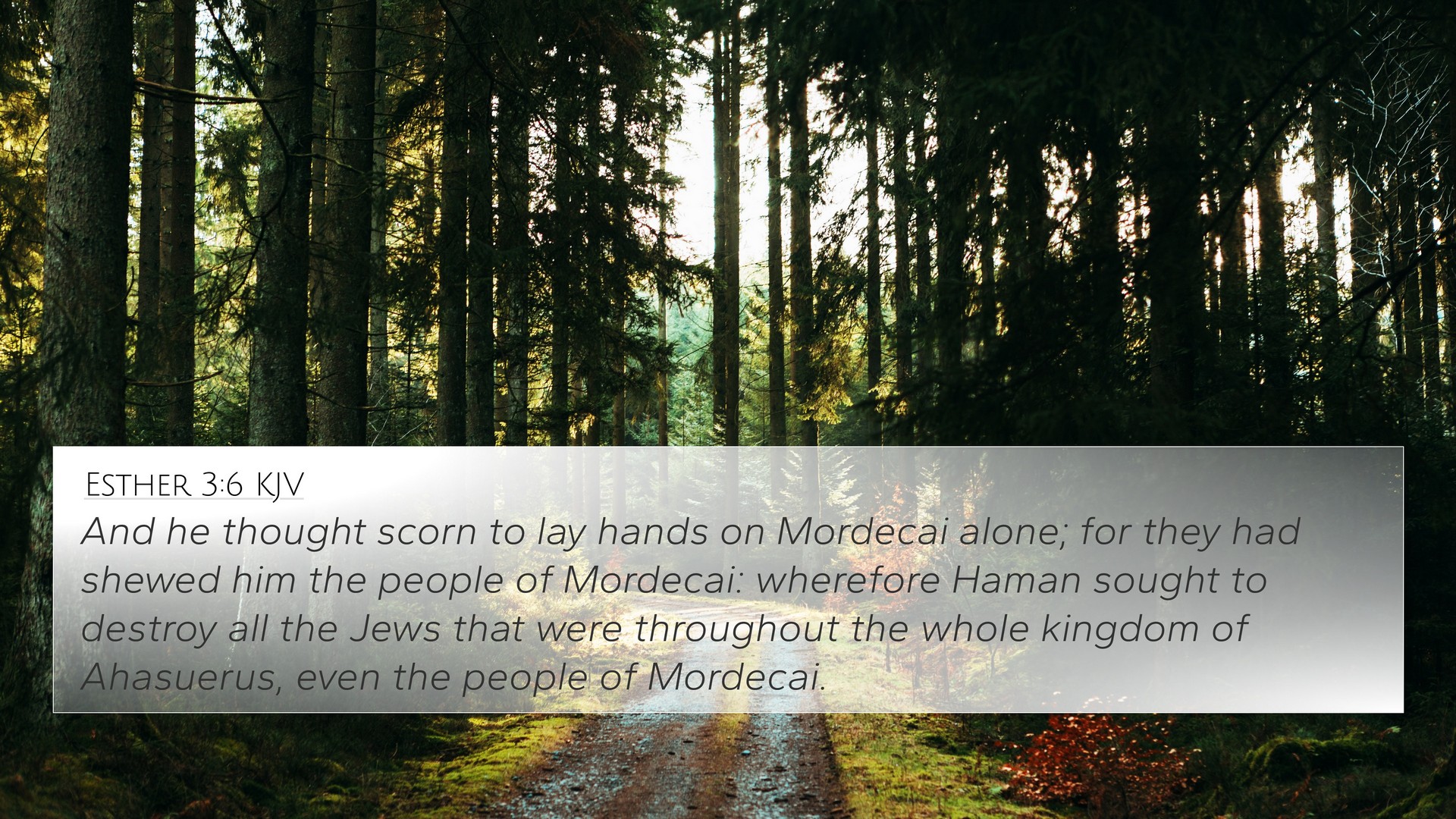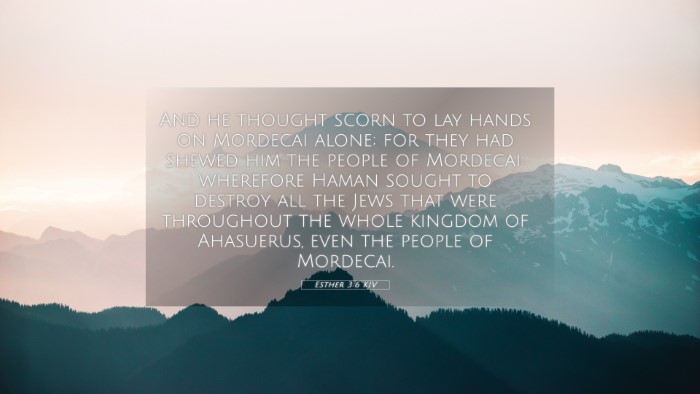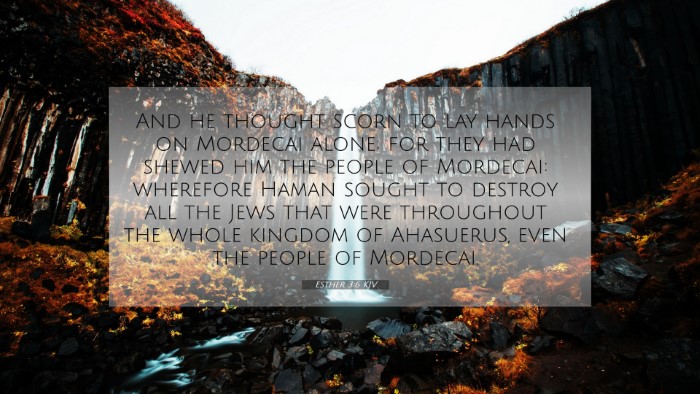Old Testament
Genesis Exodus Leviticus Numbers Deuteronomy Joshua Judges Ruth 1 Samuel 2 Samuel 1 Kings 2 Kings 1 Chronicles 2 Chronicles Ezra Nehemiah Esther Job Psalms Proverbs Ecclesiastes Song of Solomon Isaiah Jeremiah Lamentations Ezekiel Daniel Hosea Joel Amos Obadiah Jonah Micah Nahum Habakkuk Zephaniah Haggai Zechariah MalachiEsther 3:6 Similar Verses
Esther 3:6 Cross References
And he thought scorn to lay hands on Mordecai alone; for they had shewed him the people of Mordecai: wherefore Haman sought to destroy all the Jews that were throughout the whole kingdom of Ahasuerus, even the people of Mordecai.
Uncover the Rich Themes and Topics of This Bible Verse
Listed below are the Bible themes associated with Esther 3:6. We invite you to explore each theme to gain deeper insights into the Scriptures.
Esther 3:6 Cross Reference Verses
This section features a detailed cross-reference designed to enrich your understanding of the Scriptures. Below, you will find carefully selected verses that echo the themes and teachings related to Esther 3:6 KJV. Click on any image to explore detailed analyses of related Bible verses and uncover deeper theological insights.
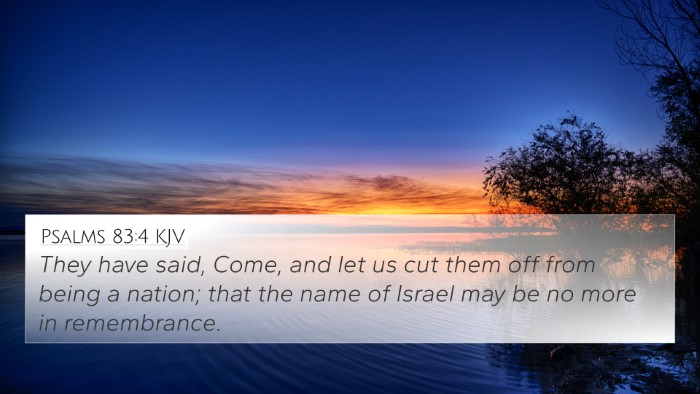
Psalms 83:4 (KJV) »
They have said, Come, and let us cut them off from being a nation; that the name of Israel may be no more in remembrance.
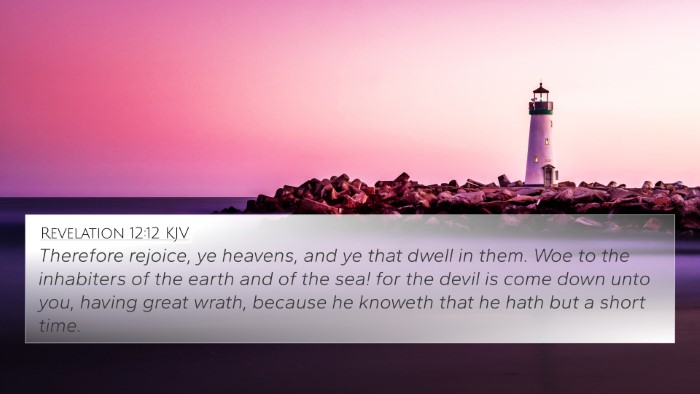
Revelation 12:12 (KJV) »
Therefore rejoice, ye heavens, and ye that dwell in them. Woe to the inhabiters of the earth and of the sea! for the devil is come down unto you, having great wrath, because he knoweth that he hath but a short time.
Esther 3:6 Verse Analysis and Similar Verses
Understanding Esther 3:6
Esther 3:6 states, "And he sought to destroy all the Jews that were throughout the whole kingdom of Ahasuerus, even the people of Mordecai." This verse encapsulates the hostility and machination directed against the Jewish people during the reign of King Ahasuerus, primarily motivated by Haman's rage towards Mordecai.
Contextual Insight
The Book of Esther narrates a critical moment in the Jewish history during the Persian Empire. Haman's plot against the Jews signifies a common theme of anti-Semitism encountered in biblical narratives. Understanding this verse requires an examination of Haman's motivations and the broader implications for the Jewish people.
Analysis of Haman's Character
According to Matthew Henry, Haman's ambition and pride led him to a position of power, which he exploited to seek revenge on Mordecai, who refused to bow to him. Haman's desire to annihilate all Jews reflects broader themes of intolerance and hatred in power dynamics.
God's Sovereign Plan
Albert Barnes interprets this verse through the lens of God’s providence. Despite Haman's schemes, the unfolding events reveal God’s purposes as He preserves His people through Esther, illustrating the theme that human actions may seek to thwart divine will but ultimately cannot succeed.
Thematic Connections
Adam Clarke emphasizes the significance of divine deliverance in the face of adversity. This episode highlights the consistent biblical narrative of God's protection over His chosen people, alongside the recurring motif of enemies arising against them. This theme resonates throughout the scripture, providing a rich tapestry of divine faithfulness despite human treachery.
Cross-References for Deeper Study
- Genesis 37:24-28 - The story of Joseph and his brothers sets a precedent for hostility against God's people.
- Exodus 1:22 - Pharaoh's decree to kill Israelite boys parallels Haman's edict against the Jews.
- Neh. 4:7-8 - Opposition to the rebuilding of Jerusalem's walls shows continued antagonism towards the Jews.
- Psalms 83:4 - A prayer for deliverance against those who conspire against Israel illustrates ongoing threats.
- Isaiah 54:17 - A promise that no weapon formed against God’s people will prosper reinforces God’s protection.
- Matthew 2:16 - King Herod’s actions against Jesus reflect the continuing theme of political oppression of God’s chosen.
- Romans 8:31 - Assurance that if God is for us, who can be against us, ties into the overarching theme of divine advocacy.
- Revelation 12:17 - The dragon's war against the offspring of the Woman, representing Jewish lineage, highlights eschatological threats.
- Acts 7:9-10 - The betrayal of Joseph by his brothers serves as a historical reflection of similar injustices faced by God's people.
- Philippians 1:28 - Encouragement in the face of opposition ties back to the principle found in Esther’s story.
User Intent and Thematic Exploration
This verse not only denotes a pivotal moment in the Book of Esther but also invites further exploration into the connections between scripture and themes of divine protection, the nature of evil, and the persistent conflict faced by God’s people throughout biblical history. For those seeking to understand how this verse connects to broader biblical themes, engaging with these cross-references provides a comprehensive insight.
Using Cross-References in Study
A practical approach to understanding biblical texts involves employing tools for Bible cross-referencing. Here are some useful methods:
- Consult a Bible Concordance: This can help to find related scripture and thematic connections.
- Use a Bible Cross-Reference Guide: These resources typically highlight verses that correlate with each other.
- Engage in Cross-Reference Bible Study: By comparing verses, one can uncover deeper meanings and insights.
- Employ a Bible Cross-Reference System: Understanding how verses interact can enrich one's study and application of biblical principles.
Conclusion
Esther 3:6 serves as a vital entry point into the themes of conflict, divine providence, and the resilience of God's people. By engaging in comparative Bible verse analysis, you can uncover profound insights about the nature of God’s protection, the reality of spiritual warfare, and the importance of standing firm amidst adversity. In this, we find both comfort and encouragement, knowing that God’s purposes prevail even when faced with great opposition.
